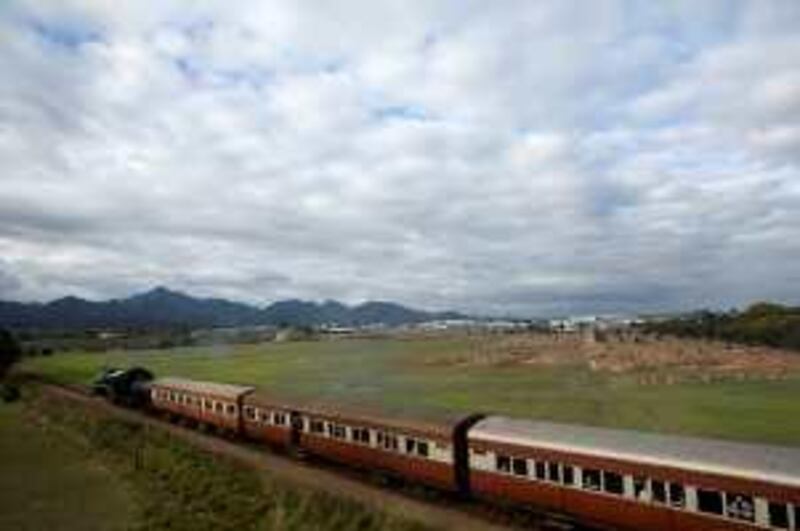GEORGE, SOUTH AFRICA // First the puffs of smoke and steam appear in the distance, then the mournful wail of the whistle sounds across the landscape. Next the high-speed panting of the engine is heard, before finally it melds with the rhythmic clanking of the wheels and the Outeniqua Choo-Tjoe rolls by. As it curved around the hillside descending to Groot Brak River, a huddle of houses on a coastal estuary in South Africa's Western Cape, it looked for all the world like something from the 1950s. Engine No 2694, a Class 19D built by the North British Locomotive Co in Glasgow in 1939 and named Rosie, pulled four vintage carriages behind it. But when the train approached its destination, below the snow-capped Outeniqua mountains it is named after and passing the main town cemetery on its way into George, it was going to its own grave. The Outeniqua Choo-Tjoe was the last scheduled steam-powered service in Africa, and until storm damage forced a diversion it ran on a line regarded as one of the most spectacular railway journeys in the world. Before setting off on its final journey on Friday, the driver, Jan Beneke, 52, who has worked for South Africa's railways for 32 years, said he was "not happy to go off the steam now. We can't tell you how we feel." When the original 67km track was laid from George to the coastal town of Knysna in the 1920s it was believed to be the most expensive railway ever constructed. From its departure point it passed through forests and over river gorges before descending to the coast, where it hugged the cliff face on specially built cuttings - at times the only thing between the waves and the rock - crossed multiple wetlands and river mouths, including the curved bridge over the Kaaimans, before traversing the Knysna lagoon over more than 2.5km of causeways and bridges. When steam power was finally phased out on South Africa's main lines in the 1980s - sanctions and the innate conservatism of apartheid South Africa meant that technological advances at times passed it by, with nationwide television broadcasts only beginning in 1976 - a decision was made to keep it on the George-Knysna line as a preservation and heritage project. But while the route was visually stunning, the landscape that was at the heart of its unique appeal proved its downfall. In 2006 and again in 2007, it was hit by floods, leaving sections of the track covered by landslides, and others suspended in mid-air as the ground beneath them was washed away. At the time the repair bill was estimated at 150 million rands (Dh70m) - now it is undoubtedly higher - and Transnet, South Africa's infrastructure utility, declined to go ahead. The Choo-Tjoe route was switched to run from George to Mossel Bay - where Bartolomeu Dias put in for water and supplies in 1488 after becoming the first European to round the Cape of Good Hope and still a picturesque journey - but has been losing a six-figure sum every month. Now Transnet has suspended the Choo-Tjoe, and although negotiations are continuing with private businesses and the Western Cape provincial government with a view to restoring it, there are no guarantees the sound of steam will be heard again on the line - to the distress of the tourist industry in George, which has played host to travellers from around the world wanting to take the Choo-Tjoe. Nonetheless even the George-Knysna line has never been profitable, admitted Kobus Volschenk, the operations manager in George. "It's never been commercially viable when you take into account maintenance on the line and maintenance of the rolling stock. It's the main reason they have decided to close down the line. "From a business point of view it's the right decision, but from a personal point of view it's sad to see the train going." The line was intended as a means of transporting wood from the forests and plantations of Knysna to the sawmills of George, as well as moving passengers. Even now piles of logs and freshly sawn timber stand outside the factories close to the station, but since the track was cut they have been brought in and taken out by road. Passengers on the last Choo-Tjoe were largely local residents, accompanied by South African railway buffs. "I'm heartbroken," said Christine Schnaufer, 57, who lives in George. "The whole point is George is not a violently attractive town; the backbone of the town is the railway." "It's sad," said Hansie Swart, 40, a farmer and steam enthusiast from Swellendam, 200km away, who has taken the train several times and got up at 5am to do so once more. "There's no doubt steam trains are more romantic. Lots of things in life are romantic, but not economically viable, that's why governments have departments of culture and heritage, to retain these things." But it is perhaps understandable that, aside from the financial case, South Africa's powers-that-be have little sympathy for or emotional attachment to the Choo-Tjoe. Under apartheid, train driving was one of the occupations reserved for whites, allowing the state to privilege its own. By coincidence, for 38 years George was the constituency of PW Botha, the former prime minister who defended the racist system until being ousted in 1989 and lived in Wilderness, on the George-Knysna line. "It's ridiculous; it's a travesty," said Keith Evans, 58, retired, who lives in Wilderness himself. "It's typical. The government don't want to put money into anything that doesn't benefit their voters." Nonetheless the majority sentiment was one of nostalgia and regret. Franccois Uys, who travelled with Mr Swart and was on board for the first time, said: "The experience is just that it's like a whole new world. "You have been driving the N2 [motorway] your whole life and there's a whole world that's running alongside you and you haven't even noticed it for 40 years. One day you wake up and a friend opens the curtains and it's the last day." sberger@thenational.ae
The Choo-Tjoe train chugs into history
Following extremely costly storm damage to the tracks, South Africa's last scheduled steam-powered service has been terminated.

Editor's picks
More from the national




